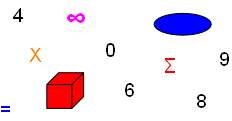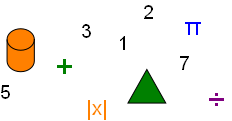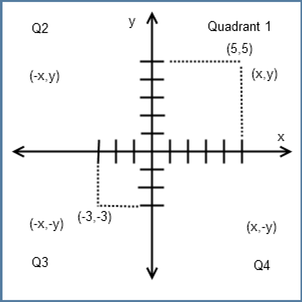



Algebra


Algebra is best defined as a generalized and abstracted basic mathematics. In basic math emphasis is on simple operations applied to numbers or discrete values to provide a result. This is true for simple algebra.
Elementary algebra steps beyond discrete numbers and constant terms to include variables, symbols that can represent a numeric value or quantity. Variables are literal numbers (or literal factors): a, b, c, x, y or z. Symbols specifying a constant value can be represented by Greek, Latin or other symbol. The Greek letter π (pi) is a mathematical constant for the ratio of a circle's circumference to its diameter, approximately 3.1416.
Literals, capitalized or lower-case are different symbols. “A” is not “a”, “B” is not “b”. Lower-case is often used for a literal factor.
Algebra has operations not considered basic math. The Greek letter ∑ (sigma) designates summation of a set having a range of values.
By combining constant and variable symbols, what is numbers in basic math expands to the concept of a term. In algebra, all mathematical operations are applied on terms. A number is a coefficient of a term. A simple term could be a number, a literal number, or a number and a literal number: 4x3, meaning “x” cubed is multiplied by the coefficient four.

Cartesian Coordinates for Elementary and Advanced Study.
Terms Expressions Equations Form and Function
Terms combined with math operations form expressions. An algebraic expression with two or more terms is a multinomial. A simple expression is: 4x2 + 2x + 6; an expression with 3 terms.
When a value for “x” is provided the terms can be evaluated for value and written as an equation 4x2 + 2x + 6 = y. The equation by using an expression provides a solution for y, the value of y. We could just as easily write 4x2 + 2x + 6 as 2 (2x2 + x + 3), each the mathematical expression of the other as equivalent different form, identity. Then, 4x2 + 2x + 6 = 2 (2x2 + x + 3) = y.
Much of math from algebra onward is working with equations, expressions and forms of expressions.
Math equations and expressions can define very abstract algebra relationships. Suppose the mass of matter and energy. If we could prove mathematically that mass is equivalent to energy then that aspect of mass and energy becomes an expressed relationship, an expression of the other; the same with different identity. This is what Albert Einstein demonstrated with E = MC2. It means the energy contained in matter (E) is equal to the mass of the matter (M) times the speed of light (C) squared. This equation helped prove the mass of matter and energy are not separate, but different forms of the same thing. I can’t think of a better way to say it; an expression is a different form of the same!
Algebra is often taught as a math by itself to learn rules, properties and permutations of operations on terms using symbols. Its legacy is a math of trigonometry and geometry as a language enabling the description of many physical shapes and forms in their absence, and therefore provides abstract representation of physical shapes or forms. The algebraic equation is an expression of identity, an abstract representation by symbols, letters and operations that do not look anything like the physical shape or form. The specific shape or form can be created or constructed from the abstract representation.
Advanced algebra curriculum is often referenced as pre-calculus or elementary functions. In algebra we write equations;
4x2 + 2x + 6 = y. In pre-calculus or elementary functions we write f(x) = 4x2 + 2x + 6; f(x), is a function of x, then f(x) = y. They are similar with differences attributed to subject emphasis on particular math topics by author(s) of the text. f(x) often represents a two dimensional or three dimensional map relationship as Cartesian coordinates (x, y) or (x, y, z) where the equation defining f(x) specifies a set or range of values, the domain of the function as line, area or other function type.
Advanced Math Properties that Help Solve Equations
Substitution Property - The equation formed by substituting one expression for an equal expression in an equation is equivalent to the original equation.
Substitution Property Example:
5x − 4x = 6; x ( 5 − 4 ) = 6; x(1) = 6; x = 6
Addition Property - The equation formed by adding (or subtracting) the same quantity to both sides of an equation is equivalent to the original equation.
Addition Property Examples:
x − 4 = 6; x − 4 + 4 = 6 + 4; x = 10
x + 5 = 12; x + 5 − 5 = 12 − 5; x = 7
Multiplication Property - The equation formed by multiplying (or dividing) the same quantity to both sides of an equation is equivalent to the original equation.
Multiplication Property Examples:
1/3 × x = 6; (1/3) × 3 × x = 6 × 3; (1) x = 18; x = 18
5x = 20; 5x / 5 = 20 / 5; x = 4
Typical Algebra Curriculum
- Real Number Set Theory
- Operations of Algebraic Expressions
- Factoring
- Algebraic Fractions
- Linear Equations and Inequalities in One Variable
- Exponents and Radicals
- Quadratic Equation in one variable
- Linear Equations Involving Two Variables
- Relations and Functions
- Exponential and Logarithmic Functions
- Polynomial Functions
- Analytic Geometry of Conic Sections
- Trigonometric Functions
- Sequences and Series (of terms, arithmetic or geometric)
Think of algebra as advanced basic math; that the purpose of basic math is the necessary foundation of algebra. Basic math often incorporates pre-algebra concepts, though that algebra is restricted to simple formulas relating trigonometric shapes, geometric shapes and lines. There usually isn’t an absolute delineation that separates one topic from another in mathematics. It’s fuzzy, it integrates. What is absolute is that algebra establishes the foundation for all other branches of mathematics beyond basic math.
Copyright © DigitMath.com
All Rights Reserved.
| Addition |
| Subtraction |
| Multiplication |
| Division |
| Prime Numbers |
| Decimals and Place Value |
| Square Root |
| Rational and Irrational Numbers |
| Multiplication Table |
| Adding Decimals |
| Subtracting Decimals |
| Multiplying Decimals |
| Square Numbers Conversion Tables |
| Adding Fractions |
| Subtracting Fractions |
| Multiplying Fractions |
| Dividing Fractions |
| Fractions to Decimals |
| Fraction to Percent |
| Trigonometric Functions Table |
| Radians |
| Sine Graph |
| Cosine Graph |
| Tangent Graph |
| Using Trigonometric Functions Table |
| Babylonian/Pythagorean/Egyptian |
| Greek Mathematics |
| Chinese Indian Islamic Math |
| Medieval European Renaissance Math |
| Scientific Revolution Math |
| Modern Math |
| Twentieth Century Math |
| Factoring Polynomials |
| Factors and Factoring Defined |
| Prime Factorization |
| Algebraic Expressions and Math Terms |
| Important Algebraic Expressions |
| Difference of Squares |
| Factoring Trinomials |
| Factoring by Grouping |
| Cube-Formula(s) |
| Graphing Linear Equations |
| Linear Equations In Two Variables |
| System of Equations |
| Linear Function |
| Distance Formula |
| Midpoint Formula |
| Absolute Value |
| Polynomial Long Division |
| Synthetic Division |
| Radicals Adding Subtracting |
| Radical Expressions |
| Simplifying Radical Expressions |
| Factoring Quadratic Equations |
| Factoring by Completing the Square |
| Quadratic Equation Formula |
| Common Logarithm Tables |
| Logarithms Definition |
| Logarithm Properties |
| Common Logarithms |
| Antilogs |
| Natural Logarithms |
| Sequence Convergence & Divergence |
| Summation Notation |
| Factorials |
| Factorials for Binomial Expansion |
| Pascals Triangle |
| Mathematical Induction |
| What are Parallelograms? |
| Parallelogram Area |
| Perimeter of a Parallelogram |
| What is a Quadrilateral? |
| 3×3 Matrix Determinant |
| 4×4 Matrix Determinant |
| 3×3 Cramer’s Rule |
| Circle |
| Ellipse |
| Parabola |
| Hyperbola |